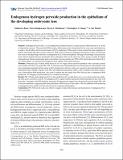| dc.contributor.author | Basu, Subhasree | en_US |
| dc.contributor.author | Rajakaruna, Suren | en_US |
| dc.contributor.author | Dickinson, Bryan C. | en_US |
| dc.contributor.author | Chang, Christopher J. | en_US |
| dc.contributor.author | Menko, A. Sue | en_US |
| dc.date.accessioned | 2014-05-06T16:17:15Z | |
| dc.date.issued | 2014 | en_US |
| dc.identifier.citation | Basu, Subhasree, Suren Rajakaruna, Bryan C. Dickinson, Christopher J. Chang, and A. Sue Menko. 2014. “Endogenous hydrogen peroxide production in the epithelium of the developing embryonic lens.” Molecular Vision 20 (1): 458-xxx. | en |
| dc.identifier.issn | 1090-0535 | en |
| dc.identifier.uri | http://nrs.harvard.edu/urn-3:HUL.InstRepos:12152895 | |
| dc.description.abstract | Purpose Hydrogen peroxide (H2O2) is an endogenously produced reactive oxygen species (ROS) present in a variety of mammalian systems. This particular ROS can play dichotomous roles, being beneficial in some cases and deleterious in others, which reflects the level and location of H2O2 production. While much is known about the redox regulation of ROS by antioxidant and repair systems in the lens, little is known about the endogenous production of H2O2 in embryonic lens tissue or the physiologic relevance of endogenous H2O2 to lens development. This gap in knowledge exists primarily from a lack of reagents that can specifically detect endogenous H2O2 in the intact lens. Here, using a recently developed chemoselective fluorescent boronate probe, peroxyfluor-6 acetoxymethyl ester (PF6-AM), which selectively detects H2O2 over related ROS, we examined the endogenous H2O2 signals in the embryonic lens. Methods: Embryonic day 10 chick whole lenses in ex vivo organ culture and lens epithelial cells in primary culture were loaded with the H2O2 probe PF6-AM. To determine the relationship between localization of mitochondria with active membrane potential and the region of H2O2 production in the lens, cells were exposed to the mitochondrial probe MitoTracker Red CMXRos together with PF6-AM. Diphenyleneiodonium (DPI), a flavin inhibitor that blocks generation of intracellular ROS production, was used to confirm that the signal from PF6-AM was due to endogenous ROS production. All imaging was performed by live confocal microscopy. Results: PF6-AM detected endogenous H2O2 in lens epithelial cells in whole lenses in ex vivo culture and in lens epithelial cells grown in primary culture. No endogenous H2O2 signal could be detected in differentiating lens fiber cells with this probe. Treatment with DPI markedly attenuated the fluorescence signal from the peroxide-specific probe PF6-AM in the lens epithelium, suggesting that basal generation of ROS occurs in this region. The lens epithelial cells producing an endogenous H2O2 signal were also rich in actively respiring mitochondria. Conclusions: PF6-AM can be used as an effective reagent to detect the presence and localization of endogenous H2O2 in live lens cells. | en |
| dc.language.iso | en_US | en |
| dc.publisher | Molecular Vision | en |
| dc.relation.hasversion | http://www.ncbi.nlm.nih.gov/pmc/articles/PMC3984042/pdf/ | en |
| dash.license | LAA | en_US |
| dc.title | Endogenous hydrogen peroxide production in the epithelium of the developing embryonic lens | en |
| dc.type | Journal Article | en_US |
| dc.description.version | Version of Record | en |
| dc.relation.journal | Molecular Vision | en |
| dash.depositing.author | Dickinson, Bryan C. | en_US |
| dc.date.available | 2014-05-06T16:17:15Z | |
| dash.contributor.affiliated | Dickinson, Bryan | |


